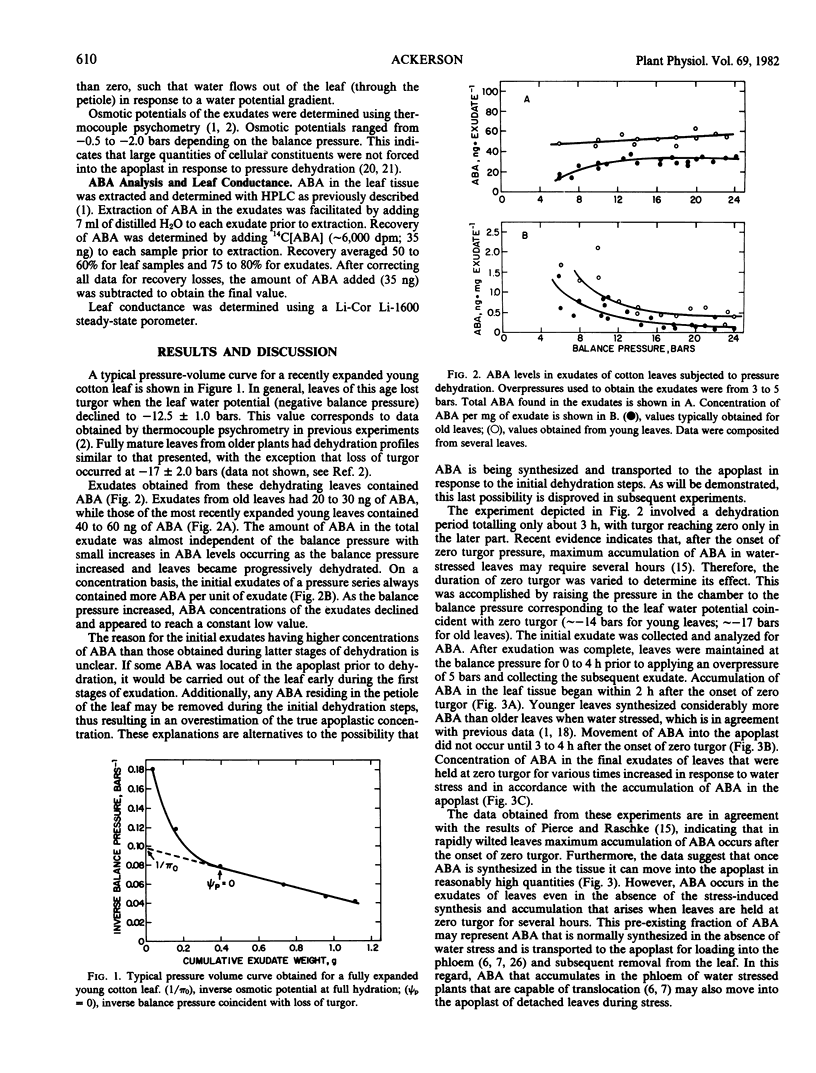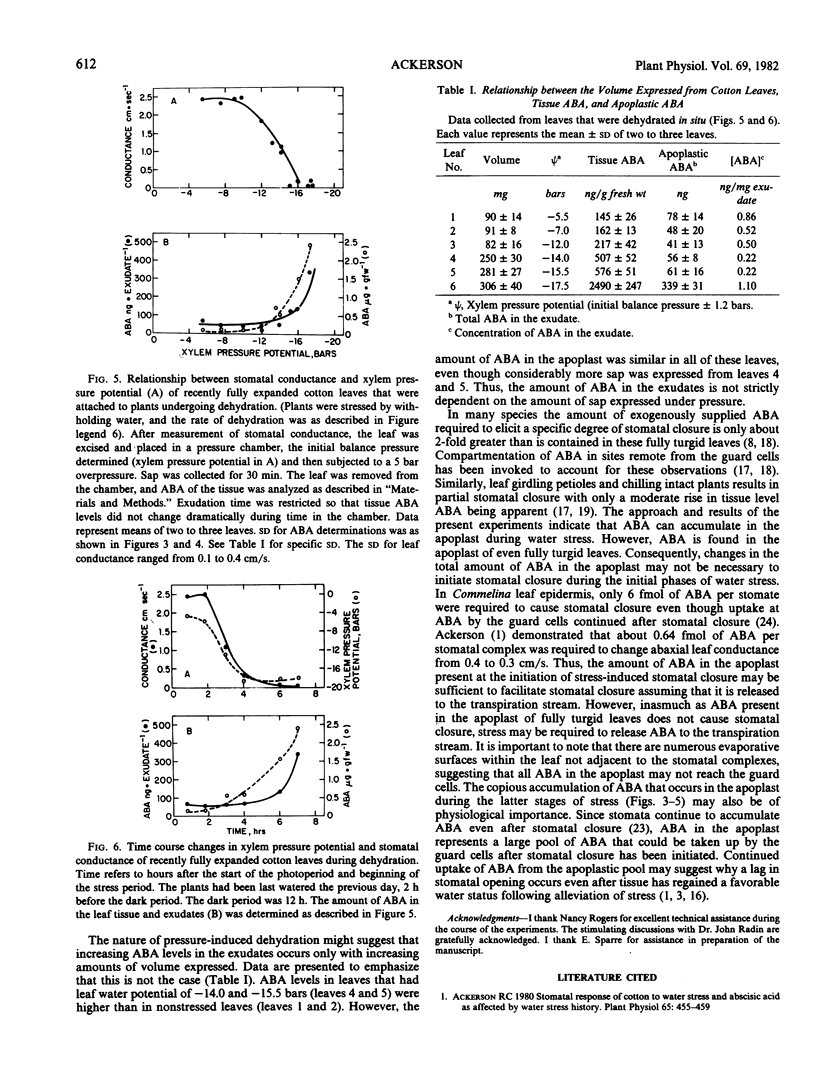Abstract
Synthesis and movement of abscisic acid (ABA) into the apoplast of water-stressed cotton (Gossypium hirsutum L.) leaves were examined using pressure dehydration techniques. The exudates of leaves dehydrated in a pressure chamber contained ABA. The level of ABA in the exudates was insensitive to the leaf water potential when dehydration occurred over a 3-hour period. When leaves were rapidly dehydrated in the pressure chamber and held at a balance pressure coincident with the point of zero turgor, ABA accumulated in the leaf tissue and then in the apoplast, but only after 2 to 3 hours of zero turgor. Slow dehydration of leaves by equilibration over varying mannitol concentrations resulted in some accumulation of ABA prior to the point of zero turgor, but ABA accumulated in the tissue and apoplast most rapidly after the onset of zero turgor.
When intact plants were allowed to dehydrate, stomata of leaves attached to the plant began closing as the leaf water potential decreased to −12 bars. Leaves began accumulating ABA at about −14 bars, but accumulation of ABA in the apoplast did not occur until the leaf water potential reached −16 bars. Although the apoplastic fraction of ABA should represent an “active” pool of ABA readily accessible to the guard cells, the data suggest that there may be stomatal closure prior to accumulation of ABA in the apoplast. A role for the small amounts of apoplastic ABA not dependent upon water stress is proposed for this initial stressinduced stomatal response.
Full text
PDF




Selected References
These references are in PubMed. This may not be the complete list of references from this article.
- Ackerson R. C., Hebert R. R. Osmoregulation in Cotton in Response to Water Stress : I. ALTERATIONS IN PHOTOSYNTHESIS, LEAF CONDUCTANCE, TRANSLOCATION, AND ULTRASTRUCTURE. Plant Physiol. 1981 Mar;67(3):484–488. doi: 10.1104/pp.67.3.484. [DOI] [PMC free article] [PubMed] [Google Scholar]
- Ackerson R. C. Stomatal response of cotton to water stress and abscisic Acid as affected by water stress history. Plant Physiol. 1980 Mar;65(3):455–459. doi: 10.1104/pp.65.3.455. [DOI] [PMC free article] [PubMed] [Google Scholar]
- Beardsell M. F., Cohen D. Relationships between Leaf Water Status, Abscisic Acid Levels, and Stomatal Resistance in Maize and Sorghum. Plant Physiol. 1975 Aug;56(2):207–212. doi: 10.1104/pp.56.2.207. [DOI] [PMC free article] [PubMed] [Google Scholar]
- Kriedemann P. E., Loveys B. R., Fuller G. L., Leopold A. C. Abscisic Acid and stomatal regulation. Plant Physiol. 1972 May;49(5):842–847. doi: 10.1104/pp.49.5.842. [DOI] [PMC free article] [PubMed] [Google Scholar]
- Raschke K., Pierce M., Popiela C. C. Abscisic Acid Content and Stomatal Sensitivity to CO(2) in Leaves of Xanthium strumarium L. after Pretreatments in Warm and Cold Growth Chambers. Plant Physiol. 1976 Jan;57(1):115–121. doi: 10.1104/pp.57.1.115. [DOI] [PMC free article] [PubMed] [Google Scholar]
- Raschke K., Zeevaart J. A. Abscisic Acid Content, Transpiration, and Stomatal Conductance As Related to Leaf Age in Plants of Xanthium strumarium L. Plant Physiol. 1976 Aug;58(2):169–174. doi: 10.1104/pp.58.2.169. [DOI] [PMC free article] [PubMed] [Google Scholar]
- Setter T. L., Brun W. A., Brenner M. L. Effect of obstructed translocation on leaf abscisic Acid, and associated stomatal closure and photosynthesis decline. Plant Physiol. 1980 Jun;65(6):1111–1115. doi: 10.1104/pp.65.6.1111. [DOI] [PMC free article] [PubMed] [Google Scholar]
- Zabadal T. J. A water potential threshold for the increase of abscisic Acid in leaves. Plant Physiol. 1974 Jan;53(1):125–127. doi: 10.1104/pp.53.1.125. [DOI] [PMC free article] [PubMed] [Google Scholar]
- Zeevaart J. A. Sites of Abscisic Acid Synthesis and Metabolism in Ricinus communis L. Plant Physiol. 1977 May;59(5):788–791. doi: 10.1104/pp.59.5.788. [DOI] [PMC free article] [PubMed] [Google Scholar]


